The dream of the open road can quickly turn into a roadside nightmare if you buy the wrong used campervan. You’re excited to start your new life on wheels, but you are also worried about buying a “lemon” that will drain your bank account and ruin your travel plans. You’re not sure what to look for beyond a nice paint job and a cool interior.
This guide helps you see past the surface. You’ll learn the 15 most critical, non-negotiable red flags to spot from hidden rust and faulty electrics to shady paperwork.
This is your essential campervan inspection checklist for buying a used campervan that will save you thousands in the long run.
Red Flags 1-4: Critical Mechanical & Structural Issues
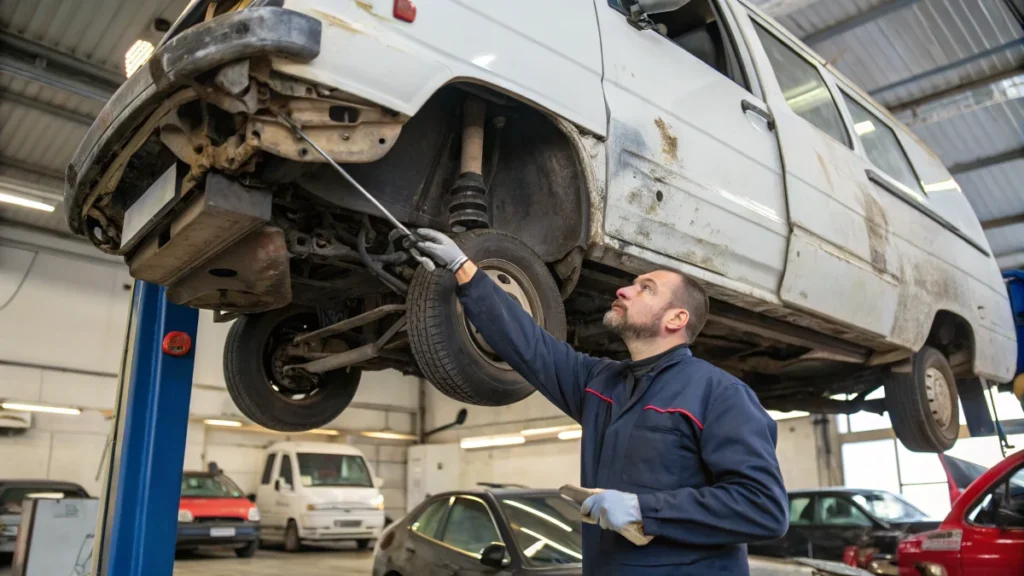
Mechanical problems are often the most expensive to fix. If the van’s bones aren’t good, nothing else matters. Pay close attention to these deal-breakers.
1. Frame Rust & Chassis Corrosion
Rust is more than a cosmetic issue; it can destroy the structural integrity of your van. You need to know the difference between surface rust, which is treatable, and frame rot, which is a death sentence for the vehicle.
Get on your back and slide underneath the van with a good flashlight. Check the main frame rails, the cross members, and the areas around the suspension. If you see flaking, bubbling metal or can poke a hole through it with a screwdriver, that’s frame rot. Walk away immediately.
Some vans, like older Sprinters and Transits used in wet or snowy climates, are known for rust issues, so inspect them extra carefully.
2. Engine Warning Lights & Odd Noises
An illuminated “Check Engine” light is an obvious red flag. But a bigger one is a seller who says, “Oh, my mechanic just cleared that code.” This often means they are hiding a recurring problem. Bring a cheap OBD-II scanner (you can buy one online for under $50) and plug it in to see if any codes have been recently erased.
Turn the engine on and listen. Do you hear a deep knocking, a high-pitched whining, or a metallic grinding? These sounds point to serious problems that could cost a fortune. A full engine or transmission replacement in 2025 can easily cost you $5,000 to $10,000.
3. Black, Blue, or White Smoke from Exhaust
The color of the exhaust smoke tells you a story about the engine’s health. Have the seller start the van while you stand behind it and watch the tailpipe.
- Black Smoke: The engine is burning too much fuel. This could be a simple fix or a sign of a major sensor issue.
- Blue Smoke: The engine is burning oil. This points to worn piston rings or seals, which is an expensive internal engine repair.
- White Smoke: If it’s thick and sweet-smelling, it’s likely a coolant leak from a blown head gasket, one of the most brutal engine repairs.
Engine Smoke Diagnostics
Black Smoke
Engine is burning too much fuel. Could be a simple fix or a major sensor issue.
Blue Smoke
Engine is burning oil. Indicates worn piston rings or seals, an expensive internal repair.
White Smoke
Thick and sweet-smelling points to a coolant leak, likely a blown head gasket – a brutal repair.
4. Uneven Tire Wear
Look closely at all four tires. Is the tread worn down on the inside or outside edges? This is a clear sign of alignment or suspension problems. It could be something simple, but it could also point to worn-out components or even a bent frame from a past accident. Don’t let a seller tell you it just needs a cheap alignment; it’s often a symptom of a much larger issue. This is a key part of what to look for in a used camper.
Red Flags 5-7: Signs of Water Damage and Leaks
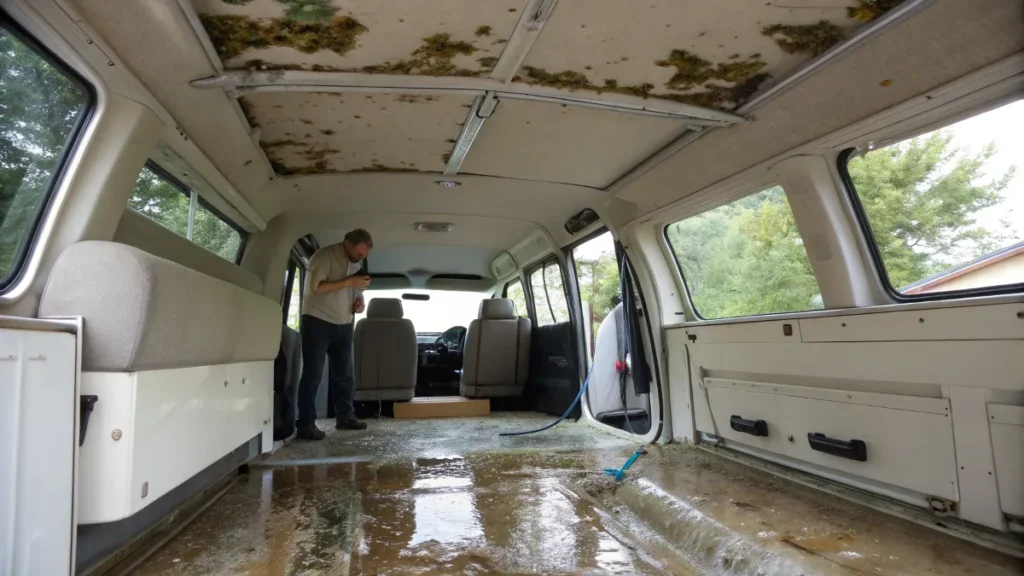
Water is the number one enemy of any campervan. It silently destroys the structure, causes mold, and leads to repairs that can cost more than the van is worth. Here’s how to spot its calling cards.
5. Musty Smell or Visible Mold
Your nose is one of your best tools. When you first step into the van, take a deep breath. A persistent musty, damp smell is a huge red flag for a hidden leak. Mold is not only a sign of water damage, but it’s also a serious health hazard.
Check for it everywhere. Open every cabinet, look under the sink, lift the corners of the mattress, and inspect the areas around windows and roof fans. If you see black or green spots, there’s a leak somewhere.
6. Water Stains, Warped Wood, or Soft Spots
Look for discoloration or stains on the ceiling panels and walls, especially in the corners. Run your hands over wood surfaces; do they feel warped or swollen?
Most importantly, press firmly on the floor and walls all around the van. If an area feels spongy or soft, it means the wood underneath has rotted from water damage. This is a massive repair job that requires tearing out the interior.
Water Damage? Let’s Investigate!
Ceilings & Walls
Look for discoloration or stains, especially in the corners. Run your hands over wood surfaces – do they feel warped or swollen?
The “Push Test”
Press firmly on the floor and walls. If an area feels spongy or soft, it indicates hidden wood rot.
The Dreaded Consequence
Spongy spots mean massive repair job, requiring tearing out the interior due to rotten wood underneath.
7. Poorly Sealed Windows, Vents, or Roof Racks
Every hole cut into a van is a potential leak point. Inspect the sealant around all windows, roof fans, and solar panel mounts. You want to see a clean, consistent bead of professional-grade sealant, like butyl tape under the fixture.
What you don’t want to see is cracked, peeling, or discolored silicone slapped on top of old sealant. This is a cheap, temporary fix and a sign the owner was patching leaks instead of fixing them properly. These are the used campervan red flags that can save you from a soggy future.
Red Flags 8-10: Dodgy DIY Conversion Work
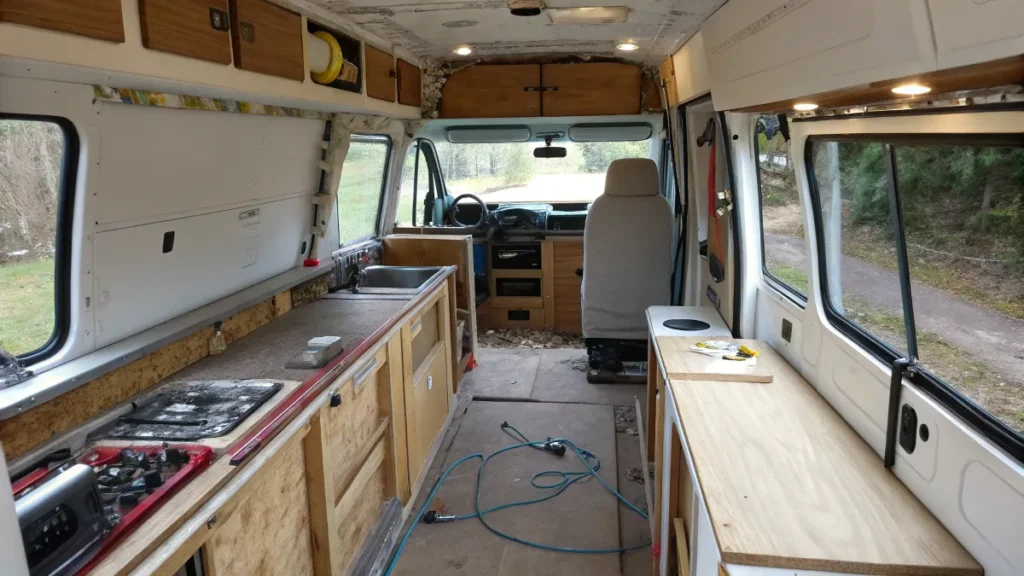
A beautiful-looking interior can hide dangerous and lazy construction. A bad DIY conversion isn’t just an inconvenience; it can be a serious fire or safety risk.
8. A Messy, Undocumented Electrical System
The electrical system is the heart of a campervan, but a bad one is a ticking time bomb. Ask the seller to show you the wiring. If you see a “rat’s nest” of unlabeled, tangled wires, that’s a major red flag.
A safe system has wires that are properly sized, neatly organized, and connected to a fuse block. Every circuit should be protected by a fuse. Ask the seller if they have a wiring diagram. If they don’t know how their own system works, you shouldn’t trust it. According to experts on forums like Reddit’s r/vandwellers, faulty wiring is a leading cause of van fires.
9. Unsafe Propane/Gas Setup
If the van uses propane for cooking or heating, the setup must be safe. A propane tank should be stored in a sealed locker or box that is vented directly to the outside of the van. This ensures that if the tank ever leaks, the heavier-than-air gas flows out of the vehicle instead of pooling on the floor and creating an explosion risk. Look for proper copper lines and fittings, not just a flexible rubber hose running through the living space.
Propane Safety is Paramount!
10. Lack of Insulation or Vapor Barrier
Proper insulation is what makes a van livable in both hot and cold weather. It also helps prevent condensation, which can lead to rust and mold from the inside out. The seller should be able to show you pictures from the building process that prove insulation was installed.
If they have no photos and can’t confidently tell you what kind of insulation they used, you should assume it was done poorly or not at all. This is a critical part of a good DIY camper build.
Red Flags 11-13: Title, History, and Paperwork Problems
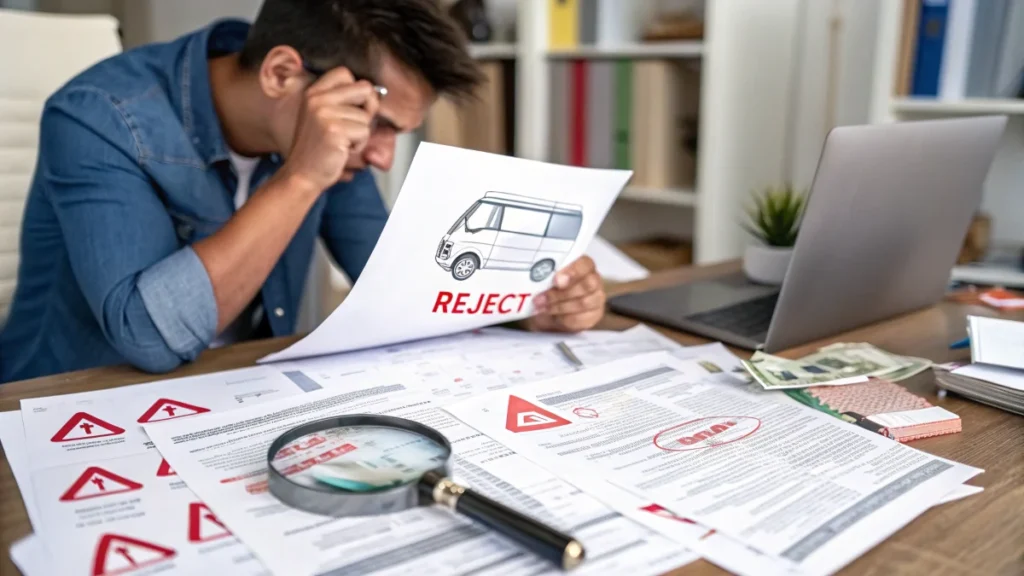
A great van with bad paperwork is a bad deal. Title and history issues can prevent you from insuring, registering, or ever reselling the vehicle.
11. Title Issues (Salvage, Rebuilt, or Lien)
Always ask to see the vehicle’s title. Here’s what to look for:
- Salvage Title: The vehicle was declared a total loss by an insurance company. It’s illegal to drive on the road.
- Rebuilt Title: A salvage vehicle that has been “repaired” and passed a basic inspection. These vans are hard to insure and have a very low resale value because of their history of major damage.
- Lien: The seller still owes money on the van to a bank. The bank legally owns the vehicle until the loan is paid off, and the seller cannot legally sell it to you.
12. Incomplete or Missing Service Records
A responsible owner keeps records of oil changes, tire rotations, and other maintenance. If the seller has a thick folder of receipts, it’s a great sign they cared for the vehicle. If they have no records at all and say “I did all the work myself,” be suspicious. Without proof, you have to assume the maintenance was neglected.
13. Vehicle Weight Misrepresentation
Every van has a Gross Vehicle Weight Rating (GVWR), which is the maximum safe operating weight set by the manufacturer. The weight of the conversion wood, batteries, water tanks adds up quickly. Ask the seller if they have a weigh-station ticket showing the van’s final weight. If they don’t know the weight, or if the van is close to its GVWR, it could be unsafe to drive and hard on the brakes and suspension.
Red Flags 14-15: Suspicious Seller Behavior
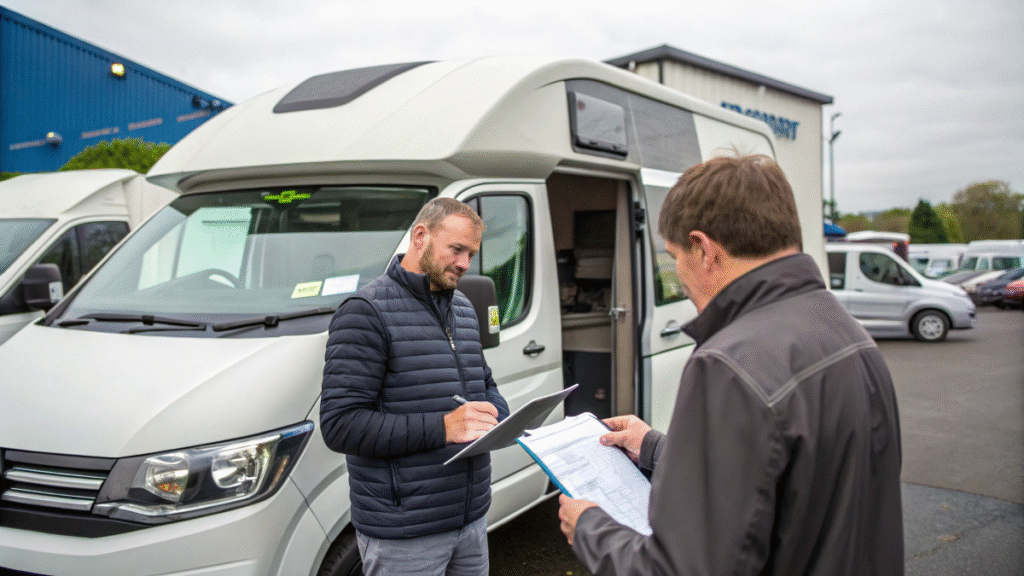
Sometimes the biggest red flag is the person selling the van. Trust your gut. If the seller seems shady, the van probably has shady secrets.
14. Seller Rushes the Inspection
A seller with a great van will be proud to show it off. They will encourage you to take your time, open every drawer, and ask a ton of questions. If the seller is trying to rush you, hovering over your shoulder, or getting impatient with your questions, they are likely trying to distract you from finding a problem they know about.
15. Vague Answers or “I Don’t Know”
You are buying a custom-built vehicle. The person who built it should know it inside and out. Ask specific questions: “What size is the water tank?” “Who did the electrical wiring?” “When was the last oil change?”
If their answers are consistently “I’m not sure” or “I don’t know,” it’s a massive used campervan red flag. A seasoned mechanic once said, “You’re buying the owner as much as you’re buying the van.” If the owner seems clueless or untrustworthy, you should not trust the vehicle.

